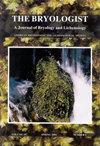The pantropical moss Plagiomnium rhynchophorum (Mniaceae) disjunct to the Southern Appalachians and Hawaii
IF 1.5
4区 生物学
Q4 PLANT SCIENCES
引用次数: 3
Abstract
Abstract. Long considered one of the best examples of a moss endemic to the Blue Ridge Escarpment of the Southern Appalachian Mountains, “Mnium carolinianum” has been reduced to synonymy with the widespread pantropical Plagiomnium rhynchophorum. It therefore joins a number of other bryophytes and ferns that represent tropical species disjunct to the moderated microenvironments provided by the deep gorges of these high-rainfall mountains. Our evidence from starch gel electrophoresis of isozymes and sequencing of both chloroplast (rps4 and rpL16) and nuclear (ITS2) DNA supports this taxonomic decision originally proposed by Timo Koponen but largely ignored in recent checklists and floras. A similar situation prevails in Hawaii, where plants previously referred to P. rostratum also proved to be P. rhynchophorum. Both of these species are allopolyploids, expressing fixed heterozygosity at diagnostic loci. Although more extensive sampling of populations and additional genetic markers are desirable, it is clear that P. rhynchophorum combines the genomes of P. maximoviczii and P. integrum, whereas P. rostratum combines the genomes of P. vesicatum and P. integrum. This conclusion is congruent with morphological evidence, which shows the allopolyploids are intermediate or combine diagnostic characters of the progenitor haploids.泛热带苔藓(蕨科),与南阿巴拉契亚山脉和夏威夷分离
摘要长期以来被认为是阿巴拉契亚山脉南部蓝岭悬崖特有苔藓的最佳例子之一,“Mnium carolinianum”已被简化为广泛分布的泛热带Plagionium rhychophorum的同义词。因此,它加入了许多其他苔藓植物和蕨类植物的行列,这些苔藓植物和蕨植物代表了与这些高降雨量山脉的深峡谷提供的温和微环境脱节的热带物种。我们从同工酶的淀粉凝胶电泳和叶绿体(rps4和rpL16)和细胞核(ITS2)DNA的测序中获得的证据支持Timo Koponen最初提出的这一分类决定,但在最近的清单和植物区系中基本上被忽视了。夏威夷也出现了类似的情况,那里以前被称为P.rostratum的植物也被证明是P.rhynchophorum。这两个物种都是异源多倍体,在诊断基因座上表达固定的杂合性。尽管需要对种群进行更广泛的采样和额外的遗传标记,但很明显,钩吻藻结合了P.maximoviczii和P.integrum的基因组,而花柄藻结合了P.vestatium和P.integrium的基因组。这一结论与形态学证据一致,表明异源多倍体是祖单倍体的中间或组合诊断特征。
本文章由计算机程序翻译,如有差异,请以英文原文为准。
求助全文
约1分钟内获得全文
求助全文
来源期刊

Bryologist
生物-植物科学
CiteScore
2.40
自引率
11.10%
发文量
40
审稿时长
>12 weeks
期刊介绍:
The Bryologist is an international journal devoted to all aspects of bryology and lichenology, and we welcome reviews, research papers and short communications from all members of American Bryological and Lichenological Society (ABLS). We also publish lists of current literature, book reviews and news items about members and event. All back issues of the journal are maintained electronically. The first issue of The Bryologist was published in 1898, with the formation of the Society.
Author instructions are available from the journal website and the manuscript submission site, each of which is listed at the ABLS.org website.
All submissions to the journal are subject to at least two peer reviews, and both the reviews and the identities of reviewers are treated confidentially. Reviewers are asked to acknowledge possible conflicts of interest and to provide strictly objective assessments of the suitability and scholarly merit of the submissions under review.
 求助内容:
求助内容: 应助结果提醒方式:
应助结果提醒方式:


